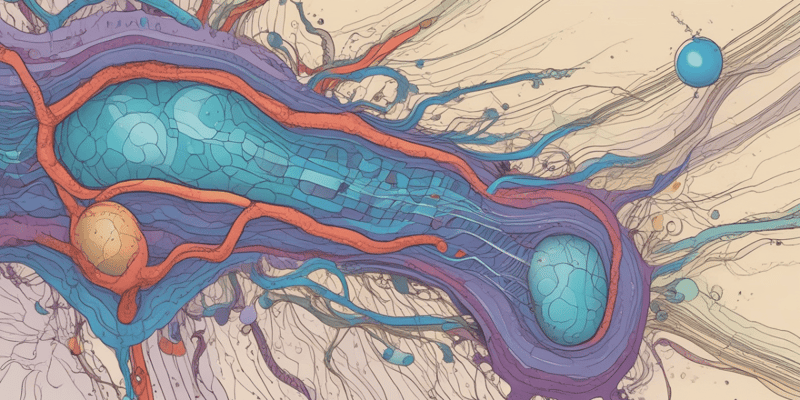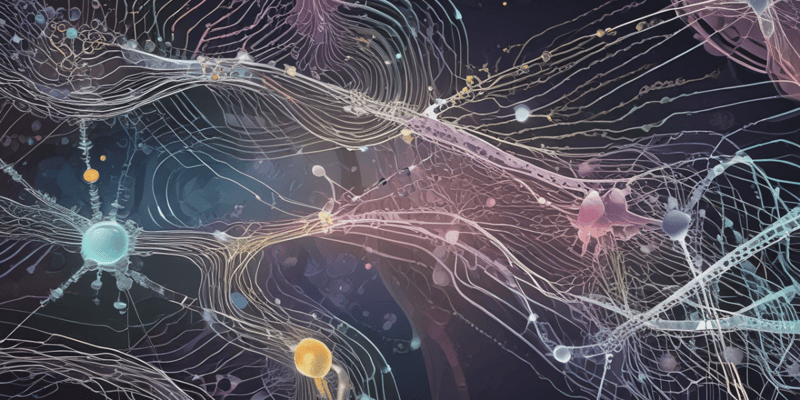30 Questions
What is the primary purpose of cell-to-cell communication?
To coordinate cellular activities and maintain homeostasis
Which type of signal is responsible for most communication within the body?
Chemical signals
What is the primary function of gap junctions?
To allow direct cytoplasmic transfer of electrical and chemical signals
What type of molecules can pass through gap junctions?
Only small molecules such as amino acids and ATP
What is the primary difference between contact-dependent signals and local communication by chemicals?
The distance over which the signal is transmitted
What is the role of long-distance communication in the body?
To transmit signals over long distances through a combination of electrical and chemical signals
What is the term for the process by which receptors become less responsive?
Desensitization
What is the role of the last signal molecule in the pathway?
It initiates synthesis of target proteins or modifies existing target proteins
What is the term for the extracellular ligands that bind to receptors?
First messengers
What is the outcome of the binding of a messenger to a receptor?
It changes the conformation of the receptor
What is the term for the process by which a signal is converted into a different form?
Signal transduction
What is the role of second messengers?
They alter enzyme function and trigger exocytosis
What type of intercellular communication involves the release of neurotransmitters at synaptic junctions?
Neural communication
What is the function of paracrine signaling in tissue development?
Development of tissues
What is the role of gap junctions in juxtacrine communication?
To enable the binding of ligands on one cell surface to receptors on another
What is the main difference between paracrine and juxtacrine signals?
The distance over which the signal is transmitted
What is the term for the series of steps by which a signal on a cell's surface is converted into a specific cellular response?
Signal transduction pathway
What type of molecule is secreted by endocrine glands or cells into the blood?
Hormones
What is the primary function of ligand binding to a G protein–coupled receptor?
To open an ion channel or alter enzyme activity
What is the role of phosphatase enzymes in signal transduction pathways?
To remove phosphates from proteins
What is the purpose of signal amplification in signal transduction pathways?
To allow a small amount of signal to have a large effect
What is the effect of ligand binding to integrin receptors?
Alteration of the cytoskeleton
What is a characteristic of multistep pathways in signal transduction?
They provide more opportunities for coordination and regulation
What is the result of the receptor-ligand complex activating an amplifier enzyme?
One ligand is amplified into many intracellular molecules
What is the function of the G protein in the GPCR signal transduction pathway?
To activate phospholipase C and initiate the signaling cascade
What is the role of diacylglycerol (DAG) in the GPCR signal transduction pathway?
To activate protein kinase C (PKC)
What is the function of IP3 in the GPCR signal transduction pathway?
To release Ca2+ from organelles and create a Ca2+ signal
What type of receptor is involved in the signal transduction pathway shown in Figure 6.9?
G protein-coupled receptor (GPCR)
What is the role of phospholipase C (PLC) in the GPCR signal transduction pathway?
To convert membrane phospholipids into diacylglycerol (DAG) and IP3
What is the effect of the signal molecule binding to the receptor-channel in Figure 6.9?
The receptor-channel opens or closes in response to signal molecule binding
Study Notes
Cell Signaling and Intercellular Communication
- Cell-to-cell communication is essential for coordination of cellular activities, maintenance of homeostasis, and control of growth and development.
- There are two types of physiological signals: electrical signals (changes in membrane potential) and chemical signals (secreted by cells into ECF).
Methods of Cell-to-Cell Communication
- Gap junctions: direct cytoplasmic transfer of electrical and chemical signals between adjacent cells (without entering the ECF).
- Contact-dependent signals: occur when surface molecules on one cell membrane bind to surface molecules on another cell’s membrane.
- Local communication: chemicals diffuse through the extracellular fluid (ECF).
- Long-distance communication: combination of electrical signals and chemical signals (hormones).
Intercellular Communication Types
- Neural communication: neurotransmitters released at synaptic junctions from nerve cells and act on a postsynaptic cell.
- Endocrine communication: hormones and growth factors reach cells via the circulating blood or lymph.
- Paracrine communication: products of cells diffuse in the ECF to affect neighboring cells.
- Autocrine communication: binds to receptors on the same cell (cell that secreted the messenger).
- Juxtacrine communication: ligand on one cell surface binds with the receptor on the surface of the next cell (relies on gap junctions or nanotubes).
Signal Transduction
- Signal transduction pathway: a series of steps by which a signal on a cell’s surface is converted into a specific cellular response.
- Signal molecule binds to a receptor, activating the receptor, which in turn activates one or more intracellular signal molecules.
- The last signal molecule in the pathway initiates synthesis of target proteins or modifies existing target proteins to create a response.
Signal Transduction Mechanisms
- Ligand-receptor binding activates the receptor, leading to the activation of intracellular signal molecules.
- Signal pathways can lead to the alteration of transcription of various genes.
- Second messengers bring about many short-term changes in cell function by altering enzyme function, triggering exocytosis, and leading to the alteration of transcription of various genes.
Signal Transduction Pathways
- G protein-coupled receptors: ligand binding opens an ion channel or alters enzyme activity.
- Integrin receptors: ligand binding alters the cytoskeleton.
- Phosphorylation cascade: a series of protein phosphorylations that act as a molecular switch, turning activities on and off.
Signal Amplification
- Signal amplification allows a small amount of signal to have a large effect.
- Receptor-ligand complex activates an amplifier enzyme (AE), which amplifies the signal.
G Protein-Coupled Receptors (GPCR)
- Membrane-spanning proteins with a cytoplasmic tail linked to a G protein.
- When G proteins are activated, they open ion channels in the membrane or alter enzyme activity on the cytoplasmic side of the membrane.
GPCR-Phospholipase C Signal Transduction
- Signal molecule activates receptor and associated G protein.
- G protein activates phospholipase C (PLC), which converts membrane phospholipids into diacylglycerol (DAG) and IP3.
- DAG activates protein kinase C (PKC), which phosphorylates proteins.
- IP3 causes release of Ca2+ from organelles, creating a Ca2+ signal.
Signal Transduction Using Ion Channels
- Receptor-channels open or close in response to signal molecule binding.
- Ion channels allow ions to flow into or out of the cell, creating an electrical signal.
Test your knowledge of cell signaling, intercellular communication, and physiological signals in the human body.
Make Your Own Quizzes and Flashcards
Convert your notes into interactive study material.
Get started for free


